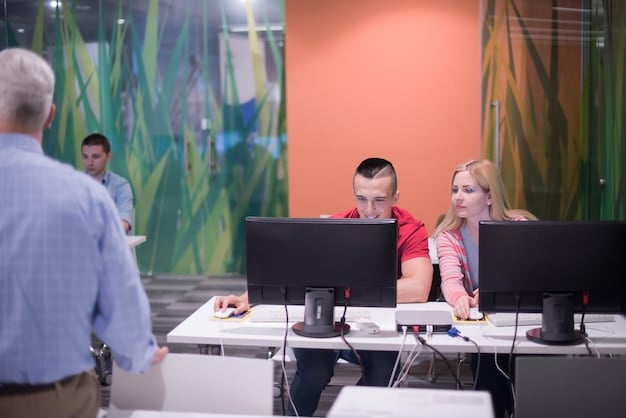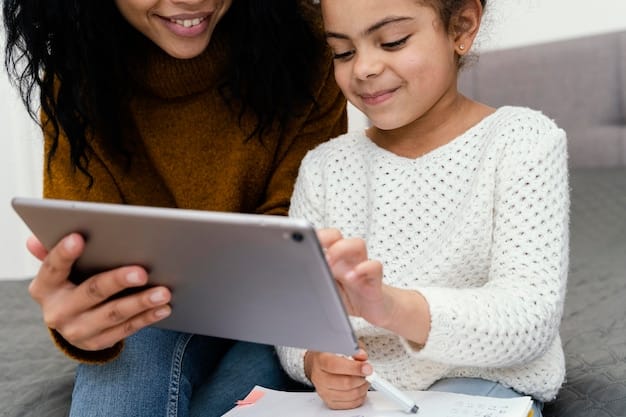The Role of Technology in Personalized Learning: Data-Driven Education in US Schools

The Role of Technology in Personalized Learning: How Schools Are Using Data to Improve Outcomes focuses on how educators in the US leverage data analytics and digital tools for individualized student experiences, refining teaching strategies, and enhancing educational effectiveness.
In today’s educational landscape, the integration of technology is revolutionizing how students learn and how educators teach. This article explores The Role of Technology in Personalized Learning: How Schools Are Using Data to Improve Outcomes, particularly in the United States, where data-driven strategies are reshaping educational practices.
Understanding the Core of Personalized Learning
Personalized learning is more than just incorporating technology in the classroom. It represents a fundamental shift in the educational approach, focusing on the individual needs, strengths, and interests of each student. Let’s delve deeper into what personalized learning truly entails.
Defining Personalized Learning
At its heart, personalized learning is about tailoring education to the unique profile of each student. This involves assessing their current knowledge, understanding their learning style, and setting goals that are relevant to their aspirations. This approach aims to empower students to take ownership of their learning journey.
Key Components of Personalized Learning
Several elements are crucial for implementing personalized learning effectively. These include flexible learning environments, customized content, data-driven instruction, and student-led goal setting. When these components work together, they create a dynamic and engaging learning experience.
- Flexible Learning Paths: Allowing students to progress at their own pace and choose learning activities that suit their preferences.
- Data-Informed Instruction: Utilizing data analytics to monitor student progress and adjust teaching strategies accordingly.
- Customized Content: Providing resources and materials that are relevant to each student’s interests and learning level.
- Student Agency: Encouraging students to take responsibility for their learning, set goals, and reflect on their progress.
By embracing these key components, educators can create a more equitable and effective learning environment for all students. The goal is to shift from a one-size-fits-all approach to one that acknowledges and celebrates individual differences.

How Technology Enables Personalized Learning
Technology plays a pivotal role in making personalized learning scalable and effective. Digital tools provide educators with the means to collect, analyze, and act upon data, enabling them to tailor instruction to meet individual student needs. Let’s explore the specific ways technology is used in personalized learning.
Data Collection and Analysis Tools
One of the most significant contributions of technology to personalized learning is the ability to gather and analyze data on student performance. Learning management systems (LMS) and educational apps collect vast amounts of data, providing insights into student progress, strengths, and areas for improvement.
Adaptive Learning Platforms
Adaptive learning platforms use algorithms to adjust the difficulty and content of lessons based on student performance. These platforms provide immediate feedback and adapt to each student’s learning pace, ensuring they are challenged appropriately.
- Personalized Feedback: Adaptive platforms offer real-time feedback, helping students understand their mistakes and improve their performance.
- Customized Content: These platforms adjust the content based on student comprehension, ensuring they are always learning at their optimal level.
- Automated Assessments: Technology automates the assessment process, freeing up educators to focus on individual student needs.
Through these technological advancements, personalized learning becomes more achievable, efficient, and impactful. Educators can make informed decisions and provide targeted support, leading to improved student outcomes.
Examples of Technology in Personalized Learning
To fully grasp the impact of technology on personalized learning, it’s helpful to examine specific examples of how digital tools are being used in classrooms. These examples highlight the diverse ways technology can enhance the learning experience. Let’s consider some concrete cases.
Use of Learning Management Systems (LMS)
LMS platforms like Canvas, Blackboard, and Moodle offer a centralized hub for managing course content, tracking student progress, and facilitating communication. These systems allow educators to create personalized learning paths and monitor student engagement.
Educational Apps and Software
Numerous educational apps and software programs cater to different subjects and learning styles. For example, math apps like Khan Academy provide personalized practice and tutorials, while language learning apps like Duolingo offer interactive lessons tailored to individual skill levels.
- Math Apps: Programs like Khan Academy provide step-by-step tutorials and practice problems, adapting to each student’s skill level.
- Language Learning Apps: Duolingo offers interactive lessons and personalized feedback, making language acquisition more engaging.
- Reading Comprehension Tools: Software like Lexia Reading Core5 helps students improve their reading skills through targeted interventions and personalized learning paths.
These examples demonstrate the versatility of technology in supporting personalized learning, providing students with access to resources and tools that cater to their unique needs and preferences. By integrating these technologies, educators can create a more dynamic and effective learning environment.

The Benefits of Data-Driven Personalized Learning
The data-driven approach to personalized learning offers numerous benefits for both students and educators. By leveraging data analytics, educators can gain valuable insights into student performance, identify areas for improvement, and tailor instruction accordingly. Let’s explore the specific advantages.
Improved Student Outcomes
One of the most significant benefits of data-driven personalized learning is the potential for improved student outcomes. When instruction is tailored to individual needs, students are more likely to stay engaged, master content, and achieve their academic goals.
Enhanced Teacher Effectiveness
Data-driven insights empower educators to make more informed decisions about their teaching strategies. By analyzing student performance data, teachers can identify effective instructional methods, adjust their approach based on student needs, and provide targeted support.
- Data Insights: Provides teachers with actionable data insights, helping them identify trends and patterns in student performance.
- Targeted Support: Allows teachers to provide targeted support to students who are struggling, ensuring they receive the help they need.
- Resource Allocation: Helps teachers allocate resources more effectively, ensuring that they are used to maximize student learning.
By embracing data-driven personalized learning, educators can create a more equitable and effective learning environment for all students. This approach enables them to provide targeted support, adjust their teaching strategies, and empower students to take ownership of their learning journey.
The Challenges of Implementing Personalized Learning
While the benefits of personalized learning are clear, implementing this approach effectively can be challenging. Schools and educators may face various obstacles, including issues related to technology access, teacher training, and data privacy. It’s important to address these challenges to ensure that personalized learning is implemented successfully.
Technology Access and Equity
One of the biggest challenges is ensuring that all students have access to the technology and internet connectivity needed for personalized learning. The digital divide can exacerbate existing inequalities, making it harder for students from low-income families to benefit from these approaches.
Teacher Training and Professional Development
Effective implementation of personalized learning requires teachers to develop new skills and competencies. Educators need training in data analysis, instructional design, and technology integration. Professional development programs are essential for preparing teachers to embrace personalized learning.
- Data Analysis Skills: Teachers need to be able to interpret data and use it to inform their instructional decisions.
- Instructional Design: Teachers need to be able to create personalized learning experiences that cater to individual student needs.
- Technology Integration: Teachers need to be able to seamlessly integrate technology into their teaching practices.
By addressing these challenges, schools and educators can ensure that personalized learning is implemented equitably and effectively. This requires a commitment to providing resources, training, and support for all stakeholders, creating a learning environment that empowers students to thrive.
Future Trends in Personalized Learning
As technology continues to evolve, personalized learning will likely undergo significant transformations. Emerging trends, such as artificial intelligence (AI) and virtual reality (VR), have the potential to further enhance the learning experience and provide even more customized instruction. Let’s explore some of these future trends.
Artificial Intelligence (AI) in Education
AI has the potential to revolutionize personalized learning by providing intelligent tutoring systems, automated feedback, and predictive analytics. AI-powered platforms can adapt to student learning styles in real-time, offering personalized support and guidance.
Virtual Reality (VR) and Augmented Reality (AR)
VR and AR technologies can create immersive learning experiences that engage students and make learning more interactive. These technologies can transport students to different environments, allowing them to explore historical events, scientific concepts, and cultural landmarks.
- Immersive Learning: VR and AR provide immersive learning experiences that capture student’s attention and make learning more engaging.
- Interactive Exploration: Students can explore different environments and concepts in a hands-on, interactive way.
- Personalized Simulations: VR and AR can be used to create personalized simulations that cater to individual student needs and learning styles.
These emerging technologies hold great promise for the future of personalized learning, offering the potential to create more engaging, effective, and customized learning experiences for all students. By embracing these innovations, educators can prepare students for success in a rapidly changing world.
| Key Concept | Brief Description |
|---|---|
| 💡 Personalized Learning | Tailoring education to meet individual student needs and learning styles. |
| 📊 Data-Driven Instruction | Using data analytics to inform teaching strategies and support student progress. |
| 💻 Adaptive Learning Platforms | Adjusting lesson difficulty and content based on student performance. |
| 🤖 AI in Education | Leveraging artificial intelligence for intelligent tutoring and personalized feedback. |
Frequently Asked Questions (FAQ)
▼
Personalized learning tailors education to meet the unique needs and preferences of each student, focusing on individual strengths and learning styles rather than a one-size-fits-all approach.
▼
Technology enables data collection and analysis, adaptive learning platforms, and access to a wide range of educational resources, making personalized learning more scalable and effective.
▼
Data-driven personalized learning can lead to improved student outcomes, enhanced teacher effectiveness, and more targeted support for struggling learners.
▼
Challenges include ensuring equitable technology access, providing adequate teacher training, and addressing data privacy concerns to effectively implement personalized learning.
▼
Future trends include the integration of artificial intelligence (AI) for intelligent tutoring and the use of virtual reality (VR) for immersive learning experiences.
Conclusion
The integration of technology into personalized learning is transforming education by enabling educators to tailor instruction to meet the unique needs of each student. While challenges remain, the potential benefits of improved student outcomes and enhanced teacher effectiveness make it a worthwhile endeavor for schools across the United States.





